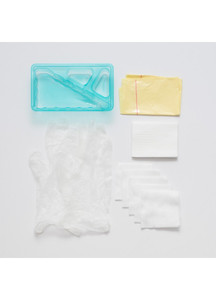
This blue dressings pack contains:
Contents
100 x Blue Assorted Plasters
6 x Blue Fingerbobs
10 x Blue Fingerstalls
1 x Empty Green Box 1060
Food Safety Act 1990
The Food Safety Act 1990 (as amended) provides the framework for all food legislation in Britain – similar legislation applies in Northern Ireland.
The main responsibilities for all food businesses under the Act are:
- to ensure you do not include anything in food, remove anything from food or treat food in any way which means it would be damaging to the health of people eating it
- to ensure that the food you serve or sell is of the nature, substance or quality which consumers would expect
- to ensure that the food is labelled, advertised and presented in a way that is not false or misleading
Hence Blue Plasters are widely used in areas of food preparation from sandwich shops to butchers to cake manufacturers.
Why Blue Plasters?
Because it gives high visibility amongst food where the colour does not naturally occur.
Why Metal Detectable Plasters?
To detect contamination in cans and foil packaging as well as cartons, trays etc.,
Sources of Contamination
a) Raw materials – wire in fabric
b) Personal effects – hair clips, coins, paper clips
c) Maintenance – swarf following repairs
d) In-Plant processing – metal slivers from knives
The Detectability of Blue Plasters
a) Sensitivity of the Metal Detector
Ideal setting should be to 2.5mm non-ferrous
Metal Detectors respond to:
a) Amplitude Detection Rejects when the signal exceeds a pre-determined level. Ideal for longer metal pieces
OR
b) Narrow zone/zero crossover
Rejects when any signal is produced
Disadvantage is that when several different size pieces pass almost together the signal from the largest piece fools the detector, which may miss the following smaller piece.
Factors affecting sensitivity
i) Type of metal
Iron is easily detected, stainless steel is not
ii) Shape of metal
Spheres are easier to detect than thin wire of the same metal “ eg 1.5mm dia stainless steel ball equates to 1.6mm wire 8mm long for detection at the same setting.
iii) Orientation of metal in product
Due to the shape of the magnetic fields in a detector, certain parts of the field are more sensitive compared to others, therefore potential blind spots can occur.
iv) Environmental Conditions
A detector operating next to a hot oven, freezing tunnels or vibration affect sensitivity.
v) Product
Dry Products “ eg cereals easy to detect metal
Fresh meat “ creates an interference signal
Pickles “ the vinegar creates a false signal
Treacle “ very dense product high sensitivity required
To ensure metal detection at low sensitivities the setting pieces used are placed in the middle of products as well as on the product.
Therefore if changing from one type of product to another, the detector settings have to be changed due to the densities of the product.





